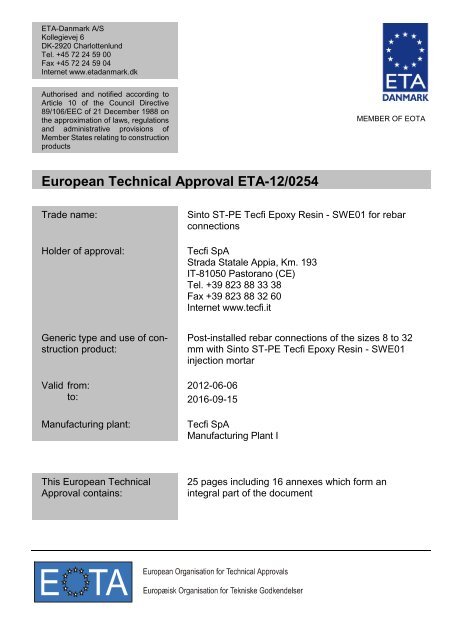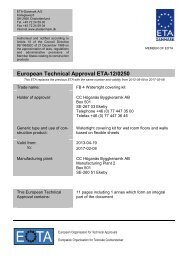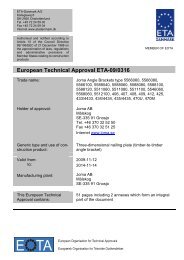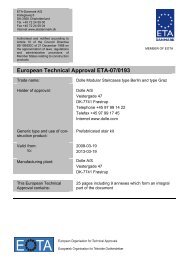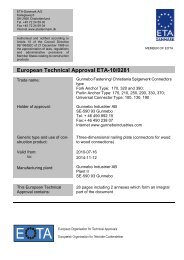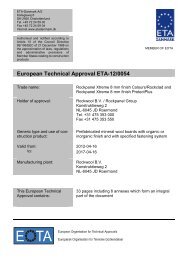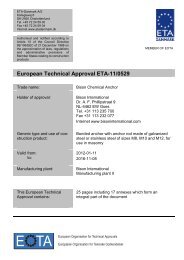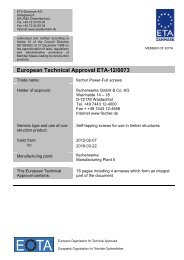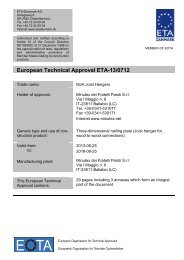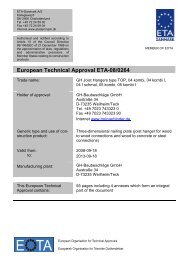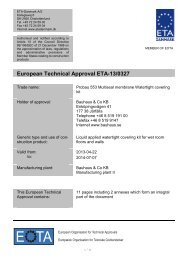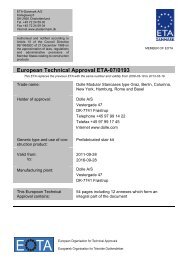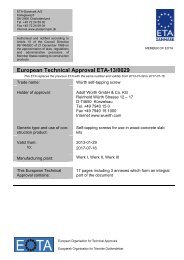ETA120254 Tecfi SWE01 rebar - ETA-Danmark
ETA120254 Tecfi SWE01 rebar - ETA-Danmark
ETA120254 Tecfi SWE01 rebar - ETA-Danmark
Create successful ePaper yourself
Turn your PDF publications into a flip-book with our unique Google optimized e-Paper software.
<strong>ETA</strong>-<strong>Danmark</strong> A/S<br />
Kollegievej 6<br />
DK-2920 Charlottenlund<br />
Tel. +45 72 24 59 00<br />
Fax +45 72 24 59 04<br />
Internet www.etadanmark.dk<br />
Authorised and notified according to<br />
Article 10 of the Council Directive<br />
89/106/EEC of 21 December 1988 on<br />
the approximation of laws, regulations<br />
and administrative provisions of<br />
Member States relating to construction<br />
products<br />
European Technical Approval <strong>ETA</strong>-12/0254<br />
Trade name:<br />
Holder of approval:<br />
Generic type and use of construction<br />
product:<br />
Valid from:<br />
to:<br />
Manufacturing plant:<br />
This European Technical<br />
Approval contains:<br />
MEMBER OF EOTA<br />
Sinto ST-PE <strong>Tecfi</strong> Epoxy Resin - <strong>SWE01</strong> for <strong>rebar</strong><br />
connections<br />
<strong>Tecfi</strong> SpA<br />
Strada Statale Appia, Km. 193<br />
IT-81050 Pastorano (CE)<br />
Tel. +39 823 88 33 38<br />
Fax +39 823 88 32 60<br />
Internet www.tecfi.it<br />
Post-installed <strong>rebar</strong> connections of the sizes 8 to 32<br />
mm with Sinto ST-PE <strong>Tecfi</strong> Epoxy Resin - <strong>SWE01</strong><br />
injection mortar<br />
2012-06-06<br />
2016-09-15<br />
<strong>Tecfi</strong> SpA<br />
Manufacturing Plant I<br />
25 pages including 16 annexes which form an<br />
integral part of the document
Page 2 of 25 pages of European Technical Approval no. <strong>ETA</strong>-12/0254<br />
I LEGAL BASIS AND GENERAL<br />
CONDITIONS<br />
1 This European Technical Approval is issued by<br />
<strong>ETA</strong>-<strong>Danmark</strong> A/S in accordance with:<br />
- Council Directive 89/106/EEC of 21<br />
December 1988 on the approximation of laws,<br />
regulations and administrative provisions of<br />
Member States relating to construction<br />
products 1 , as amended by Council Directive<br />
93/68/EEC of 22 July 1993 2 .<br />
- Bekendtgørelse 559 af 27-06-1994 (afløser<br />
bekendtgørelse 480 af 25-06-1991) om<br />
ikrafttræden af EF direktiv af 21. december<br />
1988 om indbyrdes tilnærmelse af<br />
medlemsstaternes love og administrative<br />
bestemmelser om byggevarer.<br />
- Common Procedural Rules for Requesting,<br />
Preparing and the Granting of European<br />
Technical Approvals set out in the Annex to<br />
Commission Decision 94/23/EC 3 .<br />
- <strong>ETA</strong>G 001 - Guideline for European Technical<br />
Approval of metal anchors for use in concrete<br />
– Part 5: Bonded anchors<br />
2 <strong>ETA</strong>-<strong>Danmark</strong> A/S is authorized to check<br />
whether the provisions of this European<br />
Technical Approval are met. Checking may<br />
take place in the manufacturing plant.<br />
Nevertheless, the responsibility for the<br />
conformity of the products to the European<br />
Technical Approval and for their fitness for the<br />
intended use remains with the holder of the<br />
European Technical Approval.<br />
3 This European Technical Approval is not to be<br />
transferred to manufacturers or agents of manufacturers<br />
other than those indicated on page 1,<br />
or manufacturing plants other than those<br />
indicated on page 1 of this European Technical<br />
Approval.<br />
1 Official Journal of the European Communities N o L40,<br />
11 Feb 1989, p 12.<br />
2 Official Journal of the European Communities N o L220,<br />
30 Aug 1993, p 1.<br />
3 Official Journal of the European Communities N o L 17,<br />
20 Jan 1994, p 34.<br />
4 This European Technical Approval may be<br />
withdrawn by <strong>ETA</strong>-<strong>Danmark</strong> A/S pursuant to<br />
Article 5(1) of Council Directive89/106/EEC.<br />
5 Reproduction of this European Technical<br />
Approval including transmission by electronic<br />
means shall be in full. However, partial<br />
reproduction can be made with the written consent<br />
of <strong>ETA</strong>-<strong>Danmark</strong> A/S. In this case partial<br />
reproduction has to be designated as such. Texts<br />
and drawings of advertising brochures shall not<br />
contradict or misuse the European Technical<br />
Approval.<br />
6 This European Technical Approval is issued by<br />
<strong>ETA</strong>-<strong>Danmark</strong> A/S in English.<br />
This version corresponds fully to the version<br />
circulated within EOTA. Translations into other<br />
languages have to be designated as such.
Page 3 of 25 pages of European Technical Approval no. <strong>ETA</strong>-12/0254<br />
II SPECIAL CONDITIONS OF THE<br />
EUROPEAN TECHNICAL<br />
APPROVAL<br />
1 Definition of product and intended use<br />
The subject of this approval are the post-installed<br />
connections, by anchoring or overlap connection joint<br />
consisting of steel reinforcing bars (<strong>rebar</strong>s) in existing<br />
structures made of normal weight concrete, using<br />
injection mortar Sinto ST-PE <strong>Tecfi</strong> Epoxy Resin -<br />
<strong>SWE01</strong> in accordance with the regulations for<br />
reinforced concrete construction. The design of the postinstalled<br />
<strong>rebar</strong> connections shall be done in accordance<br />
with EN 1992-1-1 (Eurocode 2). Reinforcing bars with<br />
diameters from 8 to 32 mm and Sinto ST-PE <strong>Tecfi</strong><br />
Epoxy Resin - <strong>SWE01</strong> injection mortar according to<br />
Annex 5 are used for the post-installed <strong>rebar</strong> connections<br />
covered by this <strong>ETA</strong>. The steel element is placed into a<br />
drilled hole previously injected with a mortar and is<br />
anchored by the bond between embedded element,<br />
injection mortar and concrete.<br />
Intended use<br />
The post-installed <strong>rebar</strong> connections may be used in<br />
normal weight concrete of a minimum grade C12/15 and<br />
maximum grade C50/60 according to EN 206-1. They<br />
may be used in non-carbonated concrete with the<br />
allowable chloride content of 0,40 % (Cl 0,40) related to<br />
the cement content according to EN 206-1<br />
.<br />
The <strong>rebar</strong> connections may be used for predominantly<br />
static loads.<br />
Fatigue, dynamic or seismic loading of post-installed<br />
<strong>rebar</strong> connections are not covered by this <strong>ETA</strong>.<br />
The fire resistance of the post-installed <strong>rebar</strong><br />
connections is not covered by this <strong>ETA</strong>.<br />
The <strong>rebar</strong> connections may only be carried out in the<br />
manner, which is also possible with reinforcing bars, e.g.<br />
those in the following applications:<br />
- an overlapping joint with existing reinforcement in<br />
a building component (Figures 1 and 2, Annex 2),<br />
- anchoring of the reinforcement at a slab or beam<br />
support (Figure 3, Annex 2; end support of a slab,<br />
designed as simply supported, as well as<br />
appropriate reinforcement for restraint forces),<br />
- anchoring of reinforcement of building components<br />
stressed primarily in compression (Figure 4, Annex<br />
2),<br />
- anchoring of reinforcement to cover the line of<br />
acting tensile force (Figure 5, Annex 2).<br />
The post-installed <strong>rebar</strong> connections may be installed in<br />
dry or wet concrete and it must not be installed in<br />
flooded holes. The post-installed <strong>rebar</strong> connections may<br />
be used overhead.<br />
The post-installed <strong>rebar</strong> connections may be used in the<br />
temperature range -40°C to +80°C (max. short term<br />
temperature +80°C and max. long term temperature<br />
+50°C).<br />
This <strong>ETA</strong> covers anchoring in bore holes made with<br />
hammer drilling and diamond drilling technique (wet<br />
and dry cutting system).<br />
Assumed working life<br />
The provisions made in this European Technical<br />
Approval are based on an assumed intended working life<br />
of the anchor of 50 years.<br />
The indications given on the working life cannot be<br />
interpreted as a guarantee given by the producer or the<br />
Approval Body, but are to be regarded only as a means<br />
for choosing the right products in relation to the<br />
expected economically reasonable working life of the<br />
works.
Page 4 of 25 pages of European Technical Approval no. <strong>ETA</strong>-12/0254<br />
2 Characteristics of product and<br />
assessment<br />
2.1 Characteristics of product<br />
The post-installed <strong>rebar</strong> connections correspond to the<br />
drawings and provisions given in Annexes 1 to 14. The<br />
characteristic material values, dimensions and tolerances<br />
not indicated in Annexes shall correspond to the<br />
respective values laid down in the technical<br />
documentation 4 of this European Technical Approval.<br />
Each mortar cartridge is marked with the identifying<br />
mark of the producer and with the trade name. The<br />
<strong>rebar</strong>s are either delivered with the mortar cartridges or<br />
commercial standard <strong>rebar</strong>s purchased separately.<br />
The Sinto ST-PE <strong>Tecfi</strong> Epoxy Resin - <strong>SWE01</strong> injection<br />
mortar is delivered in mortar cartridges in a size of 265<br />
ml, 400 ml and 900 ml in accordance with Annex 6.<br />
2.2 Methods of verification<br />
The assessment of fitness of the anchor for the intended<br />
use in relation to the requirements for mechanical<br />
resistance and stability and safety in use in the sense of<br />
the Essential Requirements 1 and 4 has been made in<br />
accordance with the « Guideline for European Technical<br />
Approval of Metal Anchors for use in Concrete », Part 1<br />
« Anchors in general » and Part 5 « Bonded anchors »,<br />
and EOTA Technical Report 023 “Assessment of postinstalled<br />
<strong>rebar</strong> connections”<br />
In addition to the specific clauses relating to dangerous<br />
substances contained in this European technical<br />
approval, there may be other requirements applicable to<br />
the products falling within its scope (e.g. transposed<br />
European legislation and national laws, regulations and<br />
administrative provisions). In order to meet the<br />
provisions of the Construction Products<br />
Directive, these requirements need also to be complied<br />
with, when and where they apply.<br />
4 The technical documentation of this European Technical<br />
Approval is deposited at <strong>ETA</strong>-<strong>Danmark</strong> and, as far as relevant for<br />
the tasks of the approved bodies involved in the attestation of<br />
conformity procedure, is handed over to the approved bodies
Page 5 of 25 pages of European Technical Approval no. <strong>ETA</strong>-12/0254<br />
3 Attestation of Conformity and<br />
CE marking<br />
3.1 Attestation of Conformity system<br />
The system of attestation of conformity 2 (i) (referred<br />
to as system 1) according to Council Directive<br />
89/106/EEC Annex III laid down by the European<br />
Commission provides:<br />
a) tasks for the manufacturer:<br />
1. factory production control,<br />
2. further testing of samples taken at the<br />
factory by the manufacturer in accordance<br />
with a prescribed test plan.<br />
b) tasks for the notified body:<br />
3. initial type-testing of the product,<br />
4. initial inspection of factory and of<br />
factory production control,<br />
5. continuous surveillance, assessment and<br />
approval of factory production control.<br />
3.2 Responsibilities<br />
3.2.1 Tasks of the manufacturer<br />
3.2.1.1 Factory production control<br />
The manufacturer has a factory production control<br />
system in the plant and exercises permanent internal<br />
control of production. All the elements, requirements<br />
and provisions adopted by the manufacturer are<br />
documented in a systematic manner in the form of<br />
written policies and procedures. This production control<br />
system ensures that the product is in conformity with the<br />
European Technical Approval.<br />
The manufacturer shall only use raw materials supplied<br />
with the relevant inspection documents as laid down in<br />
the control plan 5 . The incoming raw materials shall be<br />
subject to controls and tests by the manufacturer before<br />
acceptance. Check of incoming materials shall include<br />
control of the inspection documents presented by<br />
suppliers.<br />
The frequency of controls and tests conducted during<br />
production and on the assembled anchor is laid down in<br />
the control plan taking account of the automated<br />
manufacturing process of the anchor.<br />
5 The control plan has been deposited at <strong>ETA</strong>-<strong>Danmark</strong> and is<br />
only made available to the approved bodies involved in the<br />
conformity attestation procedure.<br />
The results of factory production control are recorded<br />
and evaluated. The records include at least the following<br />
information:<br />
- designation of the product, basic material and<br />
components; type of control or testing;<br />
- date of manufacture of the product and date of<br />
testing of the product or basic material and<br />
components;<br />
- result of control and testing and, if appropriate,<br />
comparison with requirements;<br />
- signature of person responsible for factory<br />
production control.<br />
The records shall be presented to the inspection body<br />
during the continuous surveillance. On request, they<br />
shall be presented to <strong>ETA</strong>-<strong>Danmark</strong><br />
Details of the extent, nature and frequency of testing<br />
and controls to be performed within the factory<br />
production control shall correspond to the prescribed<br />
test plan which is part of the technical documentation<br />
of this European Technical Approval.<br />
3.2.2. Tasks of notified bodies<br />
3.2.2.1 Initial type testing of the product<br />
For initial type testing the results of the tests<br />
performed as part of the assessment for the European<br />
Technical Approval shall be used unless there are<br />
changes in the production line or plant. In such cases<br />
the necessary initial type testing has to be agreed<br />
between <strong>ETA</strong>-<strong>Danmark</strong> and the notified body<br />
3.2.2.2 Initial inspection of factory and of factory<br />
production control<br />
The approved body shall ascertain that, in accordance<br />
with the control plan, the factory and the factory<br />
production control are suitable to ensure continuous and<br />
orderly manufacturing of the anchor according to the<br />
specifications mentioned in 2.1 as well as to the<br />
Annexes to the European Technical Approval.<br />
3.2.2.3 Continuous surveillance<br />
The approved body shall visit the factory at least once a<br />
year for regular inspection. It has to be verified that the<br />
system of factory production control and the specified<br />
automated manufacturing process are maintained taking<br />
account of the control plan.<br />
Continuous surveillance and assessment of factory<br />
production control have to be performed according to<br />
the prescribed test plan.
Page 6 of 25 pages of European Technical Approval no. <strong>ETA</strong>-12/0254<br />
The results of product certification and continuous<br />
surveillance shall be made available on demand by the<br />
certification body or inspection body, respectively, to<br />
<strong>ETA</strong>-<strong>Danmark</strong>. In cases where the provisions of the<br />
European Technical Approval and the control plan are<br />
no longer fulfilled the conformity certificate shall be<br />
withdrawn.<br />
3.3 CE marking<br />
The CE marking shall be affixed on each packaging of<br />
injection mortar cartridge. The symbol « CE » shall be<br />
accompanied by the following information:<br />
- identification number of the certification body;<br />
- name or identifying mark of the - producer and<br />
manufacturing plant;<br />
- the last two digits of the year in which the CEmarking<br />
was affixed;<br />
- number of the EC certificate of conformity;<br />
- Number of <strong>ETA</strong> Guideline<br />
- number of the European Technical Approval;
Page 7 of 25 pages of European Technical Approval no. <strong>ETA</strong>-12/0254<br />
4 Assumptions under which the fitness of<br />
the product for the intended use was<br />
favourably assessed<br />
4.1 Manufacturing<br />
The products are manufactured in accordance with the<br />
provisions of the European Technical Approval using<br />
the automated manufacturing process as identified<br />
during inspection of the plant by <strong>ETA</strong>-<strong>Danmark</strong> and the<br />
approved body and laid down in the technical<br />
documentation.<br />
4.2 Drafting<br />
Rebar connections must be designed in keeping with<br />
good engineering practice.<br />
Considering the loads to be anchored, design<br />
calculations and design drawings must be produced in a<br />
way they can be checked. At least the following items<br />
must be given in the design drawings:<br />
- grade of concrete strength,<br />
- diameter, drilling technique, concrete cover, spacing<br />
and embedment depth of the <strong>rebar</strong>,<br />
- kind of preparation of the joint between building<br />
component being connected including the thickness<br />
of concrete layer that has to be removed.<br />
4.3 Rebar connections design<br />
4.3.1 General<br />
The actual position of the reinforcement in the existing<br />
structure shall be determined on the basis of the<br />
construction documentation and taken into account when<br />
designing.<br />
The design of the post-installed <strong>rebar</strong> connections<br />
according to Annex 2 and determination of the internal<br />
section forces to be transferred in the construction joint<br />
shall be verified in accordance with EN 1992-1-1.<br />
The minimum clear spacing between two post-installed<br />
<strong>rebar</strong>s shall be: a = 40 mm ≥ 4 · Ø (according to Annex<br />
4).<br />
4.3.2 Determination of basic anchorage depth<br />
The required basic anchorage length lb,rqd shall<br />
be determined in accordance with EN 1992-1-1,<br />
clause 8.4.3:<br />
where:<br />
lb,rqd = (Ø / 4) · (σsd / fbd)<br />
Ø = diameter of the <strong>rebar</strong><br />
σsd = calculated design stress of the <strong>rebar</strong><br />
fbd = design value of bond strength according to Annex<br />
3, Table 2 and table 3<br />
in consideration of the coefficient related to the quality<br />
of bond conditions and of the coefficient related to the<br />
<strong>rebar</strong> diameter<br />
4.3.3 Determination of the design anchorage length<br />
The required design anchorage length lbd shall be<br />
determined in accordance with EN 1992-1-1, clause<br />
8.4.4:<br />
lbd = α1 · α2 · α3 · α4 · α5 · lb,rqd ≥ lb,min<br />
where: α1, α2, α3, α4, α5 determined acc. to EN 1992-1-1,<br />
Table 8.2:<br />
α1 = 1,0 for straight <strong>rebar</strong>s<br />
α2 = 0,7 ≤ α2 ≤ 1,0 calculated acc. to EN 1992-1-1,<br />
Table 8.2<br />
α3 = 1,0 because no transverse reinforcement<br />
α4 = 1,0 because no transverse reinforcement<br />
α5 = 0,7 ≤ α5 ≤ 1,0 influence of transverse pressure<br />
acc. to EN 1992-1-1, Table 8.2<br />
with:<br />
lb,rqd = according to clause 4.3.2<br />
lb,min = minimum anchorage length acc. to EN 1992-1-<br />
1, equations 8.6 and 8.7 modified with TR 023,<br />
§ 4.2<br />
lb,min = 1,5 · max {0,3 · lb,rqd; 10 Ø; 100 mm}<br />
under tension<br />
lb,min = 1,5 · max {0,6 · lb,rqd; 10 Ø; 100 mm}<br />
under compression<br />
The maximum anchorage depth is given in Annex 3,<br />
Table 1.<br />
4.3.4 Overlap joints<br />
The required design anchorage length l0 shall be<br />
determined in accordance with EN 1992-1-1, clause<br />
8.7.3:<br />
l0 = α1 · α2 · α3 · α5 · α6 · lb,rqd ≥ l0,min<br />
where: α1, α2, α3, α5, α6 determined acc. to EN 1992-1-1,<br />
Tables 8.2 and 8.3 with:<br />
α1 = 1,0 for straight <strong>rebar</strong>s<br />
α2 = 0,7 ≤ α2 ≤ 1,0 calculated acc. to EN 1992-1-1,<br />
Table 8.2<br />
α3 = 1,0 because no transverse reinforcement<br />
α5 = 0,7 ≤ α5 ≤ 1,0 influence of transverse pressure
Page 8 of 25 pages of European Technical Approval no. <strong>ETA</strong>-12/0254<br />
acc. to EN 1992-1-1, Table 8.2<br />
α6 = 1,0 ≤ α6 ≤ 1,5 influence of percentage of lapped<br />
bars relative to the total cross-section area acc.<br />
to EN 1992-1-1, Table 8.3<br />
with:<br />
lb,rqd = according to clause 4.3.2.<br />
l0,min = minimum lap length acc. to EN 1992-1-1,<br />
equation 8.11 modified with TR 023, § 4.2<br />
l0,min = 1,5 · max {0,3 α6 lb,rqd; 15 Ø; 200 mm}<br />
The maximum anchorage depth is given in Annex 3,<br />
Table 1.<br />
4.3.5 Embedment depth for overlap joints<br />
For the calculation of the effective embedment depth of<br />
overlap joints (see annex 4) the concrete cover at endface<br />
of bonded-in <strong>rebar</strong> c1 shall be considered:<br />
lv ≥ l0 + c1<br />
where:<br />
l0 = required lap length acc. to clause 4.3.4 and EN<br />
1992-1-1<br />
c1 = concrete cover at end-face of bonded-in <strong>rebar</strong><br />
If the clear distance between overlapping <strong>rebar</strong>s is<br />
greater than 4 Ø the overlap length shall be enlarged by<br />
the difference between the clear distance and 4 Ø.<br />
4.3.6 Concrete cover<br />
The concrete cover required for bonded-in <strong>rebar</strong>s is<br />
shown in Annex 4.<br />
Furthermore the minimum concrete cover given in EN<br />
1992-1-1, clause 4.4.1.2 shall be observed.<br />
4.3.7 Transverse reinforcement<br />
The requirements of transverse reinforcement in the area<br />
of the post-installed <strong>rebar</strong> connection shall comply with<br />
EN 1992-1-1, clause 8.7.4.<br />
4.3.8 Connection joint<br />
The transfer of shear forces between new concrete and<br />
existing structure shall be designed according to EN<br />
1992-1-1. The joints for concreting shall be roughened<br />
to at least such an extent that aggregate protrude.<br />
In the case of carbonated surface of the existing concrete<br />
structure the carbonated layer shall be removed in the<br />
area of the post-installed <strong>rebar</strong> connection with a<br />
diameter of Ø + 60 mm prior to the installation of the<br />
new <strong>rebar</strong>.<br />
The depth of concrete to be removed shall correspond to<br />
at least the minimum concrete cover for the respective<br />
environmental conditions in accordance with EN 1992-<br />
1-1.<br />
The foregoing may be neglected if building components<br />
are new and not carbonated and if building components<br />
are in dry conditions.<br />
4.4 Installation<br />
The fitness for use of the post-installed <strong>rebar</strong> can only be<br />
assumed if the anchor is installed as follows:<br />
- installation of the post-installed <strong>rebar</strong>s shall be<br />
carried out by appropriately qualified personnel and<br />
under the supervision of the person responsible for<br />
technical matters on the site;<br />
- use of the injection system only as supplied by the<br />
manufacturer without exchanging the components<br />
of an anchor;<br />
- installation in accordance with the manufacturer's<br />
specifications and drawings prepared for that<br />
purpose and using the tools indicated in the<br />
technical documentation of this <strong>ETA</strong>;<br />
- checks before <strong>rebar</strong> installation to ensure that the<br />
strength class of the concrete in which the anchor is<br />
to be placed is in the range given and is not lower<br />
than that of the concrete to which the characteristic<br />
loads apply;<br />
- check of concrete being well compacted, e.g.<br />
without significant voids;<br />
- check the position of existing <strong>rebar</strong>s<br />
- keeping the anchorage depth as specified in the<br />
design drawings<br />
- keeping of the edge distance and spacing as<br />
specified in the design drawings,<br />
- positioning of the drill holes without damaging the<br />
reinforcement,<br />
- in case of aborted drill hole: the drill hole shall be<br />
filled with mortar,<br />
- The drilling and cleaning of the hole and the<br />
installation shall be performed only with the<br />
equipment as specified by the manufacturer given<br />
in annexes 3 to 14. It shall be ensured that this<br />
equipment is available on site and is used<br />
- component installation temperature shall be at least<br />
+5°C,<br />
- during installation and curing of the injection<br />
mortar the temperature of the concrete must not fall<br />
below 0°C, and no more than +30°C, observing the<br />
curing time given in Annex 5<br />
4.4.1 Responsibility of the manufacturer<br />
It is the manufacturer's responsibility to ensure that the<br />
information on the specific conditions according to 1<br />
and 2 including Annexes referred to in 4.2.1. and 4.2.2.<br />
is given to those who are concerned. This information
Page 9 of 25 pages of European Technical Approval no. <strong>ETA</strong>-12/0254<br />
may be made by reproduction of the respective parts of<br />
the European Technical Approval. In addition all<br />
installation data shall be shown clearly on the package<br />
and/or on an enclosed instruction sheet, preferably using<br />
illustration(s).<br />
The minimum data required are:<br />
- drill bit diameter,<br />
- diameter of <strong>rebar</strong>,<br />
- admissible service temperature range,<br />
- curing time of the bonding material depending on<br />
the installation temperature,<br />
- information on the installation procedure, including<br />
cleaning of the hole, preferably by means of an<br />
illustration,<br />
- reference to any special installation equipment<br />
Thomas Bruun<br />
Manager, <strong>ETA</strong>-<strong>Danmark</strong><br />
needed,<br />
- identification of the manufacturing batch.<br />
All data shall be presented in a clear and explicit form.<br />
5 Recommendations on packaging, transport and<br />
storage<br />
The mortar cartridges shall be protected against sun<br />
radiation and shall be stored according to the<br />
manufacturer's instructions in dry conditions at<br />
temperatures of at least +5°C to not more than +30°C.<br />
Mortar cartridges with expired shelf life must no longer<br />
be used.
Page 10 of 25 pages of European Technical Approval no. <strong>ETA</strong>-12/0254<br />
The post-installed <strong>rebar</strong> connection consists of injection mortar Sinto ST-PE <strong>Tecfi</strong> Epoxy Resin - <strong>SWE01</strong>and an embedded<br />
straight deformed reinforcing bar with properties of class B and C according to Annex C of EC2.<br />
Covered are post-installed <strong>rebar</strong> connections in non-carbonated concrete C12/15 to C50/60 (EN 206-1) on the assumption<br />
only that the design of post-installed <strong>rebar</strong> connections is done in accordance to EN 1992-1-1. The Sinto ST-PE <strong>Tecfi</strong> Epoxy<br />
Resin - <strong>SWE01</strong>adhesive can be used in exposure class (EN 206-1) from X0 to XA.<br />
Use category:<br />
Installation in dry or wet concrete, it must not be installed in flooded holes. Overhead installation is allowable. Use category<br />
2: post-installed <strong>rebar</strong> connections in concrete Cl 0,40 (EN 206-1).<br />
Temperature range:<br />
-40°C to +80°C (max. short term temperature +80°C and max. long term temperature +50°C).<br />
Sinto ST-PE <strong>Tecfi</strong> Epoxy Resin - <strong>SWE01</strong> for <strong>rebar</strong> connections<br />
Product description and intended use<br />
Annex 1<br />
of European<br />
Technical Approval<br />
<strong>ETA</strong>-12/0254
Page 11 of 25 pages of European Technical Approval no. <strong>ETA</strong>-12/0254<br />
Sinto ST-PE <strong>Tecfi</strong> Epoxy Resin - <strong>SWE01</strong> for <strong>rebar</strong> connections<br />
Example of use for <strong>rebar</strong><br />
Annex 2<br />
of European<br />
Technical Approval<br />
<strong>ETA</strong>-12/0254
Page 12 of 25 pages of European Technical Approval no. <strong>ETA</strong>-12/0254<br />
Table 1: Drill bit diameter and setting depth 1)<br />
Rebar diameter [mm] Ø8 Ø10 Ø12 Ø14 Ø16 Ø20 Ø25 Ø28 Ø32<br />
HD 2)<br />
DD 3)<br />
HD 2)<br />
DD 3)<br />
HD 2)<br />
DD 3)<br />
Nominal drill hole<br />
d 0 [mm]<br />
Min anchorage depth<br />
l b,min [mm]<br />
Min overlap joint depth l 0, min<br />
[mm]<br />
12 14 16 18 20 25 30 35 40<br />
175 215 260 300 345 430 535 600 685<br />
300 300 300 315 360 450 565 630 720<br />
HD 2)<br />
DD 3)<br />
Max anchorage depth<br />
lv, max [mm]<br />
700 900 1100 1300 1400 1800 2200 2500 2500<br />
1) According to EN 1992-1-1 modified with TR023: lb,min (8.6) and l0,min (8.11) with maximum yield stress for <strong>rebar</strong> BSt 500S, γM = 1,15,<br />
α6 = 1,0, concrete C20/25 with fbd = 2,30 N/mm 2 and good bond condition.<br />
2) HD: hammer drilling method.<br />
3) DD: diamond drilling method (dry and wet cutting system).<br />
Table 2: Design values of the ultimate bond resistance fbd according to EN 1992-1-1 for hammer drilling<br />
method 4)<br />
Rebar<br />
diameter<br />
[mm]<br />
Ultimate bond resistance fbd [N/mm 2 ] for Hammer Drilling (HD)<br />
C12/15 C16/20 20/25 C25/30 C30/37 C35/45 C40/50 C45/55 C50/60<br />
Ø8 to Ø28 1,60 2,00 2,30 2,70 3,00 3,40 3,70 4,00 4,30<br />
Ø32 1,60 2,00 2,30 2,70 3,00 3,40 3,70 4,00 4,00<br />
Table 3: Design values of the ultimate bond resistance fbd according to EN 1992-1-1 for diamond drilling<br />
method (dry and wet cutting system) 4)<br />
Rebar<br />
diameter<br />
[mm]<br />
Ultimate bond resistance fbd [N/mm 2 ] for Diamond Drilling (DD)<br />
C12/15 C16/20 20/25 C25/30 C30/37 C35/45 C40/50 C45/55 C50/60<br />
Ø8 to Ø25 1,60 2,00 2,30 2,70 3,00 3,40 3,70 4,00 4,30<br />
Ø28 1,60 2,00 2,30 2,70 3,00 3,40 3,70 3,70 3,70<br />
Ø32 1,60 2,00 2,30 2,70 3,00 3,00 3,00 3,00 3,00<br />
4) The values given in Table 2 and 3 are valid for “good bond condition” as described on EN 1992-1-1. For all other conditions multiply<br />
the value by 0.7.<br />
Sinto ST-PE <strong>Tecfi</strong> Epoxy Resin - <strong>SWE01</strong> for <strong>rebar</strong> connections<br />
Setting depths and design values<br />
Annex 3<br />
of European<br />
Technical Approval<br />
<strong>ETA</strong>-12/0254
Page 13 of 25 pages of European Technical Approval no. <strong>ETA</strong>-12/0254<br />
Figure 6: General design rules of construction for bonded-in <strong>rebar</strong>s<br />
The following applies to Figure 6:<br />
*If the clear distance between overlapping <strong>rebar</strong>s is greater than 4Ø the overlap length shall be enlarged by the difference<br />
between the clear distance and 4Ø.<br />
The provision of sufficient transverse reinforcement according to section 4.3.7 of this approval must be verified.<br />
For the calculation of the effective embedment depth of overlap joints the concrete cover at end-face of bonded-in <strong>rebar</strong> c1<br />
shall be considered:<br />
where:<br />
lv ≥ l0 + c1<br />
l0 = required lap length acc. to clause 4.3.4 and EN 1992-1-1<br />
c1 = concrete cover at end-face of bonded-in <strong>rebar</strong><br />
c = concrete cover of bonded-in bar<br />
cmin = the minimum concrete cover is equal to:<br />
- cmin = 30 + 0,06 lv ≥ 2·Ø [mm] for hammer drilling method (HD) and for diamond drilling technique (DD, dry and<br />
wet cutting system<br />
Note: the minimum concrete cover according EC2 must be observed<br />
a = minimum clear spacing between two post-installed <strong>rebar</strong>s:<br />
- a = 40 mm ≥ 4·Ø<br />
Ø = diameter of bonded-in bar<br />
lv = effective embedment depth<br />
d0 = nominal drill bit diameter, see table 1, Annex 3<br />
Sinto ST-PE <strong>Tecfi</strong> Epoxy Resin - <strong>SWE01</strong> for <strong>rebar</strong> connections<br />
Spacing and edge distances: general rules<br />
Annex 4<br />
of European<br />
Technical Approval<br />
<strong>ETA</strong>-12/0254
Page 14 of 25 pages of European Technical Approval no. <strong>ETA</strong>-12/0254<br />
Table 4: Rebar according to EN 1992-1-1, Annex C, Tables C.1 and C.2<br />
Product form Bars and de-coiled rods<br />
Class B C<br />
Characteristic yield strength f yk or f 0,2k [N/mm 2 ] 400 to 600<br />
Minimum value of k = (f t / f y) k<br />
≥ 1,08<br />
Characteristic strain at minimum force, ε uk [%] ≥ 5,0 ≥ 7,5<br />
Bendability Bend / Rebend test<br />
Maximum deviation from nominal mass (individual<br />
bar), [%]<br />
Bond: Minimum relative rib area, f R,min<br />
Rib height h: The rib height h should be: 0,05·Ø ≤ h ≤ 0,07·Ø<br />
Ø = nominal bar diameter<br />
Table 5: Injection mortar<br />
Nominal bar size [mm]<br />
≤ 8<br />
> 8<br />
Nominal bar size [mm]<br />
Product Composition<br />
Sinto ST-PE <strong>Tecfi</strong> Epoxy Resin - <strong>SWE01</strong> two<br />
components injection mortar<br />
Table 6: Minimum curing time 5)<br />
8 to 12<br />
> 12<br />
Additive: quartz<br />
Bonding agent: epoxy resin<br />
± 6.0<br />
± 4.5<br />
0,040<br />
0,056<br />
≥ 1,15<br />
< 1,35<br />
Concrete temperature Processing time Minimum curing time 7)<br />
0°C 6) 3 h 20 min 54 h<br />
5°C 6) 2 h 30 min 41 h<br />
10°C 1 h 40 min 28 h<br />
15°C 1 h 10 min 22 h<br />
20°C 50 min 16 h<br />
25°C 30 min 14 h<br />
30°C 20 min 12 h<br />
5) The minimum time from the end of the mixing to the time when the anchor may be torque or loaded (whichever is longer).<br />
6) Minimum resin temperature recommended, for injection between 5°C and 0°C, equal to 10°C.<br />
7) Minimum curing time for dry and wet conditions.<br />
8) Maximum resin temperature for maximum anchorage length equal to 24 °C.<br />
Sinto ST-PE <strong>Tecfi</strong> Epoxy Resin - <strong>SWE01</strong> for <strong>rebar</strong> connections<br />
Materials and curing time<br />
Annex 5<br />
of European<br />
Technical Approval<br />
<strong>ETA</strong>-12/0254
Page 15 of 25 pages of European Technical Approval no. <strong>ETA</strong>-12/0254<br />
Sinto ST-PE <strong>Tecfi</strong> Epoxy Resin - <strong>SWE01</strong> for <strong>rebar</strong> connections<br />
Cartridge types and sizes<br />
Annex 6<br />
of European<br />
Technical Approval<br />
<strong>ETA</strong>-12/0254
Page 16 of 25 pages of European Technical Approval no. <strong>ETA</strong>-12/0254<br />
Manual blower pump: nominal dimensions<br />
Mixer extension (from 380 mm to 1000 mm) with nominal diameter equal to 8 mm<br />
For the hole with depth grater 1000 mm up to 2500 mm it is possible use the special<br />
mixer extension (see Annex 9) for blower operation.<br />
Sinto ST-PE <strong>Tecfi</strong> Epoxy Resin - <strong>SWE01</strong> for <strong>rebar</strong> connections<br />
Cleaning tools (1)<br />
Annex 7<br />
of European<br />
Technical Approval<br />
<strong>ETA</strong>-12/0254
Standard brush<br />
Table 7: Standard brush diameter<br />
Page 17 of 25 pages of European Technical Approval no. <strong>ETA</strong>-12/0254<br />
Rebar diameter - Ø Ø8 Ø10 Ø12 Ø14<br />
d 0 Nominal drill hole [mm] 12 14 16 18<br />
d b Brush diameter [mm] 14 16 18 20<br />
Special brush<br />
Table 8: Special brush diameter (mechanical brush)<br />
Rebar diameter - Ø Ø8 Ø10 Ø12 Ø14 Ø16 Ø20 Ø25 Ø28 Ø32<br />
d 0 Nominal drill hole [mm] 12 14 16 18 20 25 30 35 40<br />
d b Brush diameter [mm] 14 16 18 20 22 27 32 37 42<br />
Sinto ST-PE <strong>Tecfi</strong> Epoxy Resin - <strong>SWE01</strong> for <strong>rebar</strong> connections<br />
Cleaning tools (2)<br />
Annex 8<br />
of European<br />
Technical Approval<br />
<strong>ETA</strong>-12/0254
Page 18 of 25 pages of European Technical Approval no. <strong>ETA</strong>-12/0254<br />
Use the mixer extension (assembled on the standard mixer)<br />
for the injection up to 300 mm if necessary.<br />
Use this system for special conditions:<br />
Sinto ST-PE <strong>Tecfi</strong> Epoxy Resin - <strong>SWE01</strong> for <strong>rebar</strong> connections<br />
Tools for injection (1)<br />
Insert the special mixer<br />
extension in the inner<br />
diameter of the injection<br />
plug up to reach the top<br />
of the plug<br />
Annex 9<br />
of European<br />
Technical Approval<br />
<strong>ETA</strong>-12/0254
Page 19 of 25 pages of European Technical Approval no. <strong>ETA</strong>-12/0254<br />
Resin injection pump details<br />
Pump example Size cartridge Type<br />
900 ml Pneumatic<br />
400 ml Pneumatic<br />
400 ml<br />
265 ml<br />
Sinto ST-PE <strong>Tecfi</strong> Epoxy Resin - <strong>SWE01</strong> for <strong>rebar</strong> connections<br />
Tools for injection (2)<br />
Manual<br />
(up to 300 mm<br />
anchorage depth)<br />
Manual<br />
(up to 300 mm<br />
anchorage depth)<br />
Annex 10<br />
of European<br />
Technical Approval<br />
<strong>ETA</strong>-12/0254
1<br />
2<br />
3<br />
4<br />
5<br />
6<br />
Page 20 of 25 pages of European Technical Approval no. <strong>ETA</strong>-12/0254<br />
4x 4x 4x<br />
Blower Manual Standard Blower Manual<br />
Pump Brush Pump<br />
if necessary use a mixer extension for the blower<br />
operation (see Annex 7)<br />
if necessary use a mixer extension<br />
for the injection (see Annex 9)<br />
ATTENTION: Use the rods dry and free oil and other<br />
contaminants<br />
Sinto ST-PE <strong>Tecfi</strong> Epoxy Resin - <strong>SWE01</strong> for <strong>rebar</strong> connections<br />
Installation procedure up to 300 mm depth (hammer drilling)<br />
Drill the hole with the correct diameter and depth<br />
using a rotary percussive machine. Check the<br />
perpendicularity of the hole during the drilling<br />
operation.<br />
Clean the hole from drilling dust:<br />
the hole shall be cleaned by at least 4 blowing<br />
operations, by at least 4 brushing operations<br />
followed again by at least 4 blowing operations;<br />
before brushing clean the brush and check (see<br />
Annex 8, standard brush) if the brush diameter is<br />
sufficient. For the blower tools see Annex 7.<br />
Unscrew the front cup, screw on the mixer and<br />
insert the cartridge in the gun.<br />
Before starting to use the cartridge, eject a first<br />
part of the product, being sure that the two<br />
components are completely mixed. The<br />
complete mixing is reached only after that the<br />
product, obtained by mixing the two component,<br />
comes out from the mixer with an uniform color.<br />
Fill the drilled hole uniformly starting from the<br />
drilled hole bottom, in order to avoid entrapment<br />
of the air; remove the mixer slowly bit by bit<br />
during pressing-out; filling the drill hole with a<br />
quantity of the injection mortar corresponding to<br />
2/3 of the drill hole depth.<br />
Insert immediately the <strong>rebar</strong>, marked according<br />
to the proper anchorage depth , slowly and with<br />
a slight twisting motion, removing excess of<br />
injection mortar around the <strong>rebar</strong>. Observe the<br />
processing time according Annex 5. Wait the<br />
curing time according Annex 5.<br />
Annex 11<br />
of European<br />
Technical Approval<br />
<strong>ETA</strong>-12/0254
1<br />
2<br />
3<br />
4<br />
5<br />
6<br />
Page 21 of 25 pages of European Technical Approval no. <strong>ETA</strong>-12/0254<br />
4 x 5 seconds 4x 4 x 5 seconds<br />
ATTENTION: compressed air free oil<br />
ATTENTION: Use the <strong>rebar</strong> dry and free oil and other<br />
contaminants<br />
Sinto ST-PE <strong>Tecfi</strong> Epoxy Resin - <strong>SWE01</strong> for <strong>rebar</strong> connections<br />
Installation procedure up to max anchorage depth (hammer drilling)<br />
Drill the hole with the correct diameter and depth<br />
using a rotary percussive machine. Check the<br />
perpendicularity of the hole during the drilling<br />
operation.<br />
Clean the hole from drilling dust:<br />
the hole shall be cleaned by at least 4 blowing<br />
operations (5 seconds for single operation) with<br />
compressed air, by at least 4 brushing operations<br />
with special brush followed again by at least 4<br />
blowing operations (5 seconds for single<br />
operation) with compressed air. Before brushing<br />
clean the brush and check (see Annex 8, special<br />
brush) if the brush diameter is sufficient. For the<br />
blower tools see Annex 7.<br />
Unscrew the front cup of the 400 ml or 900 ml<br />
size cartridges, screw on the mixer and insert the<br />
cartridge in the proper pneumatic-pump.<br />
Before starting to use the cartridge, eject a first<br />
part of the product, being sure that the two<br />
components are completely mixed. The<br />
complete mixing is reached only after that the<br />
product, obtained by mixing the two component,<br />
comes out from the mixer with an uniform color.<br />
Before starting the injection, assemble the<br />
system according to Annex 9. After that, fill the<br />
drilled hole uniformly from the drilled hole<br />
bottom, in order to avoid entrapment of the air;<br />
remove the special mixer extension with<br />
injection plug slowly bit by bit during pressingout;<br />
filling the drill hole with a quantity of the<br />
injection mortar corresponding to 2/3 of the drill<br />
hole depth. Procedure for overhead installation<br />
are detailed in Annex 14.<br />
Insert immediately the <strong>rebar</strong>, marked according<br />
to the proper anchorage depth, slowly and with a<br />
slight twisting motion, removing excess of<br />
injection mortar around the <strong>rebar</strong>. Observe the<br />
processing time according Annex 5. Wait the<br />
curing time according Annex 5.<br />
Annex 12<br />
of European<br />
Technical Approval<br />
<strong>ETA</strong>-12/0254
1<br />
2<br />
Page 22 of 25 pages of European Technical Approval no. <strong>ETA</strong>-12/0254<br />
Drill the hole with the correct diameter and depth<br />
using a core drill machine. Check the<br />
perpendicularity of the hole during the drilling<br />
operation. Remove completely the core from the<br />
hole.<br />
After operation 1, if the diamond drilling machine used has a dry cutting system to proceed with the installation<br />
procedure according to the point 2. Instead if it is used a wet cutting system before of the point 2 the following<br />
operation must be done:<br />
- flush hole 2 times by inserting a water hose to the back of the hole until water runs clear;<br />
- brush 2 times with the proper special brush. Before brushing clean the brush and check (see Annex 8,<br />
special brush) if the brush diameter is sufficient;<br />
- flush again 2 times until water runs clear;<br />
- remove all standing water completely (using for example vacuum system or compressed air free oil).<br />
4 x 5 seconds 6x 4 x 5 seconds<br />
ATTENTION: compressed air free oil<br />
Clean the hole from drilling dust:<br />
the hole shall be cleaned by at least 4 blowing<br />
operations (5 seconds for single operation) with<br />
compressed air, by at least 4 brushing operations<br />
with special brush followed again by at least 4<br />
blowing operations (5 seconds for single<br />
operation) with compressed air. Before brushing<br />
clean the brush and check (see Annex 8, special<br />
brush) if the brush diameter is sufficient. For the<br />
blower tools see the Annex 7.<br />
After the operation above, to follow the operations from 3 to 6 on the previous Annex 12 and 11 in function of the depth of<br />
the hole.<br />
Sinto ST-PE <strong>Tecfi</strong> Epoxy Resin - <strong>SWE01</strong> for <strong>rebar</strong> connections<br />
Installation procedure with diamond drilling (wet and dry) for all depths<br />
Annex 13<br />
of European<br />
Technical Approval<br />
<strong>ETA</strong>-12/0254
Page 23 of 25 pages of European Technical Approval no. <strong>ETA</strong>-12/0254<br />
Sinto ST-PE <strong>Tecfi</strong> Epoxy Resin - <strong>SWE01</strong> for <strong>rebar</strong> connections<br />
Overhead installation procedure<br />
Annex 14<br />
of European<br />
Technical Approval<br />
<strong>ETA</strong>-12/0254
Page 24 of 25 pages of European Technical Approval no. <strong>ETA</strong>-12/0254<br />
Sinto ST-PE <strong>Tecfi</strong> Epoxy Resin - <strong>SWE01</strong> for <strong>rebar</strong> connections<br />
Design Values for anchoring connection<br />
Annex 15<br />
of European<br />
Technical Approval<br />
<strong>ETA</strong>-12/0254
Page 25 of 25 pages of European Technical Approval no. <strong>ETA</strong>-12/0254<br />
Sinto ST-PE <strong>Tecfi</strong> Epoxy Resin - <strong>SWE01</strong> for <strong>rebar</strong> connections<br />
Design Values for overlap joint connection<br />
Annex 16<br />
of European<br />
Technical Approval<br />
<strong>ETA</strong>-12/0254


